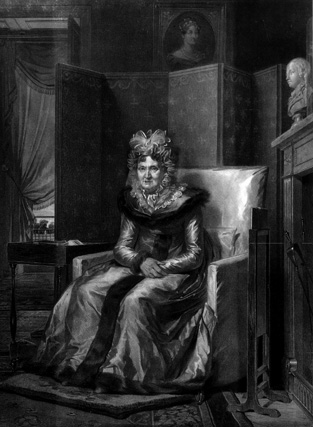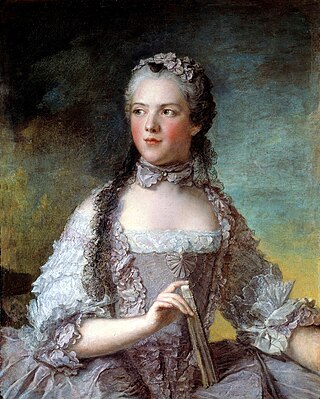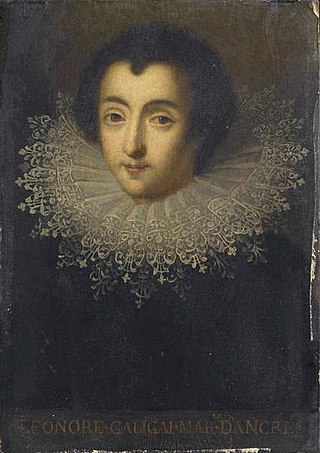
Louise-Élisabeth de Croÿ was a French noblewoman and courtier, as the Marquise of Tourzel. She was the Governess of the Children of France from 1789 until 1792. Decades after the French Revolution, Louise-Élisabeth published her memoirs, which presented a unique perspective on the royal family during the French Revolution. She later acquired the title of duchess.

Marie Adélaïde de France was a French princess, the sixth child and fourth daughter of King Louis XV and Queen Marie Leszczyńska.

Anne d'Arpajon, Comtesse de Noailles, Duchesse de Mouchy was a French noblewoman and court official. She served as the dame d'honneur of two Queens of France, Marie Leszczyńska and Marie Antoinette. She was called "Madame Etiquette" by Marie Antoinette for her insistence that the minutiae of court etiquette could never be altered or disregarded.

Victoire Armande Josèphe de Rohan, Princess of Guéméné was a French noblewoman and court official. She was the governess of the children of Louis XVI of France. She is known better as Madame de Guéméné, and was Lady of Clisson in her own right.

Marie Thérèse Louise of Savoy, Princess de Lamballe was a member of the Savoy-Carignano cadet branch of the House of Savoy. She was married at the age of 17 to Louis Alexandre de Bourbon-Penthièvre, Prince de Lamballe, the heir to the greatest fortune in France. After her marriage, which lasted a year, she went to the French royal court and became the confidante of Queen Marie Antoinette. She was killed in the massacres of September 1792 during the French Revolution.

Louise Charlotte de Noailles, Duchess of Duras, was a French courtier and memoirist. She served as lady in waiting to Marie Antoinette from 1770 to 1791.

Première dame d'honneur, or simply dame d'honneur, was an office at the royal court of France. It existed in nearly all French courts from the 16th-century onward. Though the tasks of the post shifted, the dame d'honneur was normally the first or second rank of all ladies-in-waiting. The dame d'honneur was selected from the members of the highest French nobility.

Dame d'atour was an office at the royal court of France. It existed in nearly all French courts from the 16th-century onward. The dame d'honneur was selected from the members of the highest French nobility. They were ranked between the Première dame d'honneur and the Dame du Palais.

Geneviève d'Ossun née de Gramont was a French courtier. She served as dame d'atour to the queen of France, Marie Antoinette, from 1781 until 1791, and as première dame d'honneur from 1791 until 1792.

Louise Emmanuelle de Châtillon, known as Princesse de Tarente (1763-1814) was a French noble, memoirist and court official. She served as lady-in-waiting to queen Marie Antoinette of France from 1782 to 1792. Her memoirs about her life during the French Revolution has been published.

The Dame du Palais, originally only Dame, was a historical office in the Royal Court of France. It was a title of a lady-in-waiting holding the official position of personal attendant on a female member of the French Royal Family. The position was traditionally held by a female member of a noble family. They were ranked between the dame d'atours and the Fille d'honneur. They had previously been styled 'Dames'.

Diane Louise Augustine de Polignac, was a French aristocrat, writer and courtier, and a lady-in-waiting to Princess Élisabeth of France.

Thérèse-Lucy de Dillon, was a French countess and courtier, lady-in-waiting to Queen Marie Antoinette of France (1780–82). She belonged to the intimate circle of friends of the queen and was for a while known as one of her favorites.

The House of Hénin is a family of the Belgian high nobility, one of its branches was titled Prince of Chimay. Alliances were made with important Spanish noble families such as house of Borja and the house of Velasco.

Hortense Félicité de Mailly-Nesle, Mademoiselle de Chalon, marquise de Flavacourt (1715–1799) was a French courtier, one of the five famous de Nesle sisters, four of whom would become the mistress of King Louis XV of France. Unlike each of her four sisters, she never became the king's mistress, though she was often the subject of speculations.
Adélaïde Diane Mancini called, Mancinette, was a French court official. She served as the dame d'atour to queen Marie Antoinette from 1771 to 1775. She is known to have curbed the expenses of the queen's wardrobe during her time in office and created order in the queen's economy, which was however ruined by her successor.
Marie Jeanne de Talleyrand-Périgord (1747-1792) was a French court official. She served as the dame d'atour to Queen Marie Antoinette from 1775 to 1781.
Amable Gabrielle de Noailles, Duchess of Villars, was a French court official. She served as the dame d'atour to queen Marie Leszczyńska from 1742 to 1768, and to queen Marie Antoinette from 1770 to 1771.

Édouard de Fitz-James, 6th Duke of Fitz-James was a French soldier, politician, Peer of France, and 6th Duke of Fitz-James, who descended from the British House of Stuart.
















